


Thyme - Thymus vulgaris (Labiatae - Lamiaceae, Mint family) Characteristics and uses:
Etymology: It is uncertain. One theory says the name thyme, in its Greek form, was first given to the plant by the Greeks as a derivative of the word "thymòs" which meant "breath", but also "to fumigate": they used it as incense; or coming from the Greek word "thumus" (courage, bravery), or from "thymon" (perfumed). Another theory says the name derives from the Egyptian word "tham" (an ointment used for embalming). Other uses: Essential oil of thyme contains thymol, an antiseptic and antifungal. A tea made by infusing the herb in water can be used for coughs and bronchitis. The affection of bees for thyme is well known: thyme honey has a really fine flavour. History and folklore: The ancient Greek used it in their baths and burnt it as incense in their temples: they believed it was a source of courage. Romans used it to purify their rooms, and to give an aromatic flavour to liqueurs and cheese. In Middle Ages it aided sleep and warded off nightmares, when placed beneath pillows. In the language of flowers it means courage, happiness, thriftiness, activity. ***** Erbe Matte cannot take any responsibility for any adverse effects from the use of plants. Always seek advice from a professional before using a plant medicinally***** **** We carefully dry thyme stems when they are crisp, at the first bloom; after they are dried out, we remove the leaves and flowers by sliding our fingers down each stem. **** |
 Thyme is an evergreen herb with small, aromatic leaves, for culinary, medicinal and ornamental uses. It is an "improved" cultivated form of the wild thyme of the mountains of European countries bordering on the Mediterranean, as well of Asia and North Africa. It grows as a perennial and, cultivated in hot, sunny location, gives the best of flavour. Flowers are small, white or pink, produced in late spring or summers. Thyme is sold both fresh, in bunches of sprigs, and dried. Thyme, as the relative oregano, retains its flavour on drying better than many other herbs. Thyme herb is packed with numerous health benefiting phyto-nutrients, vitamins and mineral, essential for optimum health and wellness. Its leaves are one of the richest sources of iron, potassium, manganese, magnesium, selenium, calcium. But they are also a rich source of many important vitamins (A, B complex -beta carotene-, C, E, K, and folic acid. 1997 Herb of the year.
Thyme is an evergreen herb with small, aromatic leaves, for culinary, medicinal and ornamental uses. It is an "improved" cultivated form of the wild thyme of the mountains of European countries bordering on the Mediterranean, as well of Asia and North Africa. It grows as a perennial and, cultivated in hot, sunny location, gives the best of flavour. Flowers are small, white or pink, produced in late spring or summers. Thyme is sold both fresh, in bunches of sprigs, and dried. Thyme, as the relative oregano, retains its flavour on drying better than many other herbs. Thyme herb is packed with numerous health benefiting phyto-nutrients, vitamins and mineral, essential for optimum health and wellness. Its leaves are one of the richest sources of iron, potassium, manganese, magnesium, selenium, calcium. But they are also a rich source of many important vitamins (A, B complex -beta carotene-, C, E, K, and folic acid. 1997 Herb of the year. 